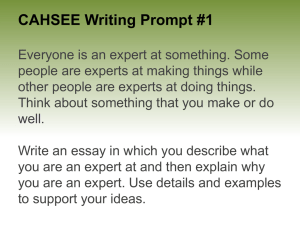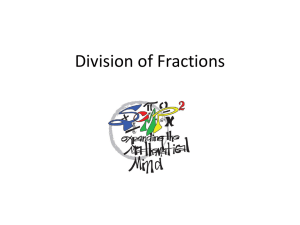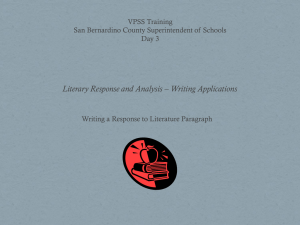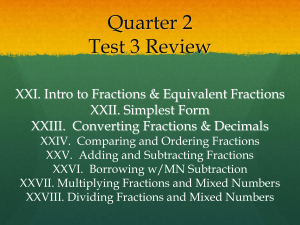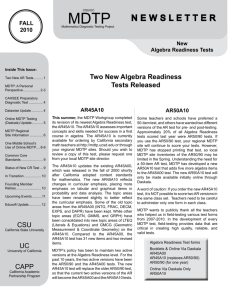PowerPoint
advertisement
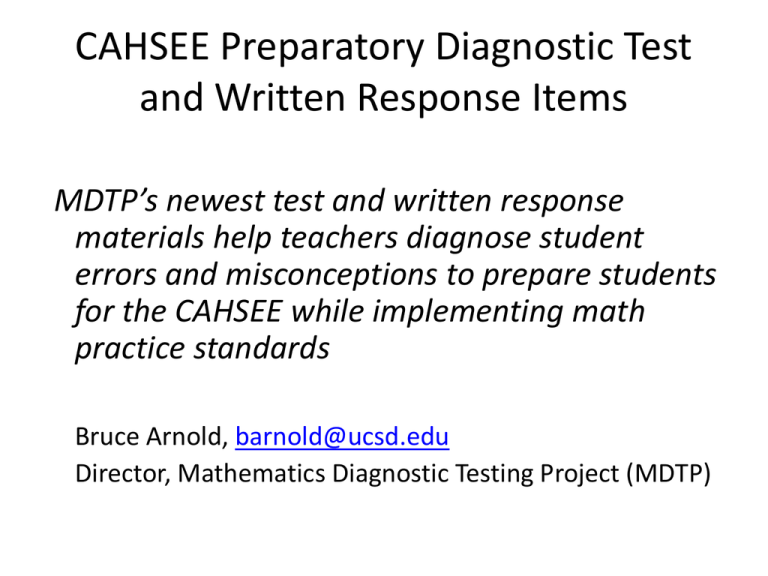
CAHSEE Preparatory Diagnostic Test and Written Response Items MDTP’s newest test and written response materials help teachers diagnose student errors and misconceptions to prepare students for the CAHSEE while implementing math practice standards Bruce Arnold, barnold@ucsd.edu Director, Mathematics Diagnostic Testing Project (MDTP) CAHSEE: High-Stakes Test • Students must pass CAHSEE to graduate from HS • CAHSEE scores are used in calculating API and AYP in Grade 10 • API: passing (“basic”) score of 350 • AYP: proficient score of 380 • Advanced score is 422 Preparing for the CAHSEE • Grades 6-9 • Dedicated 10th grade CAHSEE preparation classes • Regular 10th grade mathematics classes – Algebra I (22%) – Geometry (32%) – Algebra II (27%) MDTP CAHSEE Preparatory Diagnostic Test (CP45A12) • Helps teachers identify students’ misunderstandings so they can more effectively teach concepts and skills that are tested on the CAHSEE • Test topics include: – Integers and Exponents – Fractions, Decimals, and Percents – Data Analysis, Probability, and Statistics – Measurement of Geometric Objects – Algebra and Functions, including Algebra I – Number Line, Coordinate Plane, and Graphing Written Response Items: Objectives • Primary: – help improve students’ ability to think and communicate effectively about mathematics – provide teachers with a more accurate and detailed view of each student’s conceptual grasp of a topic – stimulate instructional activities • Secondary: – help evaluate students’ written math work – strengthen students’ understanding of math – promote examination of student work by teachers 5 Written Response Items: Components • • • • Master copy of problem Essence Statement Specific scoring rubric General scoring rubric 6 CCSS and SBAC • CCSS includes 8 Standards of Mathematical Practice – SMP 1: Make sense of problems and persevere in solving them – SMP 2: Reason abstractly and quantitatively – SMP 3: Construct viable arguments & critique others’ reasoning – SMP 6: Attend to precision • SBAC has four item types on its summative assessment – Selected response – Constructed response – Technology enhanced – Performance task 7 Standard 1: Make sense of problems and persevere in solving them • Understand the meaning of a problem and look for entry points to its solution. • Analyze givens, constraints, relationships, and goals. • Make conjectures about the form and meaning of the solution and plan a solution pathway rather than simply jumping into a solution attempt. • Consider analogous problems, and try special cases and simpler forms of the original problem in order to gain insight into its solution. • Monitor and evaluate their progress and change course if necessary. • Explain correspondences between equations, verbal descriptions, tables, and graphs and draw diagrams of important features and relationships, graph data, and search for regularity or trends. • Check their answers to problems using a different method, and continually ask themselves, “Does this make sense?” • Understand the approaches of others to solving complex problems and identify correspondences between different approaches. Standard 2: Reason abstractly and quantitatively • Make sense of quantities and their relationships in problem situations. • Decontextualize: abstract a given situation and represent it symbolically and manipulate the representing symbols • Contextualize: pause as needed during the manipulation process in order to probe into the referents for the symbols involved. • Create a coherent representation of the problem at hand; considering the units involved; attending to the meaning of quantities, not just how to compute them; and know and flexibly use different properties of operations and objects. Standard 3: Construct viable arguments and critique others’ reasoning • Understand and use stated assumptions, definitions, and previously established results in constructing arguments • Make conjectures and build a logical progression of statements to explore the truth of their conjectures • Analyze situations by breaking them into cases, and can recognize and use counterexamples • Justify their conclusions, communicate them to others, and respond to the arguments of others • Reason inductively about data, making plausible arguments that take into account the context from which the data arose • Compare the effectiveness of two plausible arguments, distinguish correct logic or reasoning from that which is flawed, and—if there is a flaw in an argument—explain what it is • Listen or read the arguments of others, decide whether they make sense, and ask useful questions to clarify or improve the arguments Standard 6: Attend to precision • Communicate precisely to others • Use clear definitions in discussion with others and in their own reasoning • State the meaning of the symbols they choose, including using the equal sign consistently and appropriately • Careful about specifying units of measure, and labeling axes to clarify the correspondence with quantities in a problem • Calculate accurately and efficiently, express numerical answers with a degree of precision appropriate for the problem context • Examine claims and make explicit use of definitions AR12COMP 1 8 • Compare the values of and 8%. State which is greater or that they are equal. Show or explain how you know. • Compare the values of 8% and 0.8. State which is greater or that they are equal. Show or explain how you know. 1 • Compare the values of 8 and 1.8. State which is greater or that they are equal. Show or explain how you know. • Write the numbers below in order from least to greatest. Show or explain how you know. 1 0.8 1.8 8% 8 12 Essence Statement • Students may convert each pair of numbers to: – Decimals and do place value comparisons – Fractions and compare using common denominators, common numerators, or cross multiplication – Percents and compare • For Part D, students may use results in Parts A, B, or C. 13 Extension Activities • Locate the numbers from Part D on a number line. 1 1 • Are there any numbers between 8 and 9 ? If there are, write one. Are there any others? Consider using a number line with your students as part of your discussion. 14 General Scoring Rubric Score 0 1 2 3 4 Category No response Minimal Partial Description Not attempted or incorrect or off task Incomplete response with major errors Reasonable approach but not well developed Satisfactory Generally well developed and presented, but contains some omissions or errors Excellent Complete, correct, and clearly stated 15 Specific Rubric (Notes) • A complete response to each of Parts A, B, and C correctly identifies the greater number and includes a complete justification. • A complete justification explains why one number is larger than the other. This explanation can be based on changing the representations of one or both numbers to a common representation - decimal, percent, or fraction. 16 Specific Rubric (Scores) Score Description 1 Correctly identifies the larger number in at least two of Parts A, B, or C without justification. 2 Correctly identifies at least one of Parts A, B, or C with complete justification OR correct order in Part D without justification. 3 Complete response to Parts A, B, and C OR a complete response to Part D. 4 Complete responses to all parts. 17 18 AR12COGR • Students are asked to plot the point P (-1, 2) in the coordinate plane. One student plots P at (2, -1). Explain to this student how to plot point P correctly. • Plot and label points P (-1, 2) and Q (-1, -3) in the coordinate plane. • Point Q is 5 units away from point P. Write the coordinates of two other points that are located 5 units away from point P. Show how you know that each point is a distance of 5 from point P. 19 Essence Statement • Starting at the origin, move left one unit and up two units to plot point P. • Both points P and Q are correctly labeled and plotted. • Points found by counting five vertical units or five horizontal units are (4, 2), (-1, 7) or (-6, 2). This requires students to look beyond the given grid. All other points with integer coordinates may be found using 3-4-5 right triangles. 20 PR12FRCO Tara is starting to learn about fractions. She asks you for help. DO NOT USE DECIMALS IN YOUR EXPLANATIONS BELOW. • Which of the two fractions, 3 or 4 , is greater? 6 6 • Which of the two fractions, 5 or 5 , is greater? 6 8 • Which of the two fractions, 1 or 3 , is greater? 8 25 21 Essence Statement • When comparing fractions with equal denominators, the fraction with the larger numerator is greater since it has a greater multiple of the unit fraction. • When comparing fractions with equal numerators, the fraction with the smaller denominator is greater since its unit fraction is greater and it has the same multiple. • When comparing fractions with unequal numerators and unequal denominators, students can compare fractions by converting them to equivalent fractions with equal denominators or with equal numerators and apply the same reasoning in Parts A and B. 22 PR12GRDN • Sam wrote 3 2 11. Is Sam correct? Show or explain how you 3 3 know. 1 • Sam’s rectangular garden has a width of 1 yards and a 2 2 length of 3 yards. Find the area in square yards of Sam’s 3 garden. • In this garden, Sam want to have11 plots of equal area to grow vegetables. Find the area in square yards of one plot. 2 1 • Ann’s rectangular garden has a width of 3 yards and a length of 3 1 yards. Whose garden is larger, Ann’s or Sam’s? 2 Show or explain how you know. 23 Essence Statement • Students may show equivalence by converting the mixed number to the improper fraction or vice versa. A diagram representing thirds could be used to show equivalence. • Students may show conversion from mixed numbers to improper fraction then multiplication of fractions. Or students may multiply mixed fraction directly, implicitly using the Distributive Property. The array method is geometric representation of this alternate approach. • Division of an improper fraction by an integer or multiplication by a unit fraction may be used. • Students may calculate Ann’s garden has a larger area using numbers or diagrams. 24 AR12LAPS 2 5 • One lap around Jen’s block is of a mile. One day Jen runs 4 laps. She recorded this distance as 1 3 5 of a mile. Was she correct? Why? • If Jen continues to run 4 laps each day, calculate the total distance she would run in 5 days. • If Jen wants to run 26.2 miles, how many laps will she need to run? • If Jen runs 4 laps each day, how many days will it take her to run 26.2 miles? 25 Essence Statement • Students may show that 4 2 8 1 3 miles. 5 5 5 • Students may show that the correct answer is 8 miles by 3 1 multiplying 5 and in various ways. Or students may use 5 3 2 repeated addition five times. Students may also use the rate 1 of 2 of 5 of a mile per miles. 5 5 × 4lap × to = 8compute 5 • Students may convert 26.2 to a mixed number first and then to an improper fraction before dividing by 2 . Or students may convert 2 5 to a decimal to obtain 26.2 65.5 laps.5 An answer of 66 is an acceptable response. 0.4 • One possible approach is to divide the number of laps Jen wants to run (65.5) by the number of laps she runs each day (4). Another possible approach is to divide the number of miles Jen wants to run (26.2) by the number of miles she runs each day (1.6). 26 AR12TRGL The points (1, 2), (-3, 2), and (-3, -1) are plotted in the coordinate plane. • Connect the plotted points to make a triangle. What is the area of this triangle? Show or explain how you found the area. • What is the perimeter of this triangle? Show or explain how you found the perimeter. • What is the slope of the hypotenuse of this triangle? Show or explain how you know. 27 Essence Statement • Students should use the lengths of the legs of the right triangle to find its area, 6 square units. They may base their calculations on a formula, diagram, or words. • Students may use the Pythagorean Theorem or recognize the Pythagorean triple (3-4-5) to find the length of the hypotenuse. Students use this length to find the perimeter of the triangle, 12 units. • Students need to recognize that the slope of the hypotenuse is positive and is written in the form of a ratio: rise 3 . Explanations could include words, run 4 diagrams, or a formula. 28 Using Written Response Items in Class • Select appropriate WR item • Provide enough time for students to think about the item and to carefully and clearly answer the questions • Collect student work and score responses using general and specific rubrics • Consider sharing general and specific rubrics with students and giving them an opportunity to score their own work and rewrite some of their responses • Keep exemplars • Record results to show student growth Future of CAHSEE • On January 8, SSPI Torlakson released “Recommendations for Transitioning California to a Future Assessment System”. Recommendation 9 suggests some changes to CAHSEE: – Instead of administering a stand-alone High School Exit Examination (CAHSEE), use the SBAC high school assessments to determine academic readiness for high school graduation. – As a proxy for meeting high school exit requirements, use the results of other voluntary exams (e.g., PSAT, SAT, ACT, or AP). These would need to be used in conjunction with a state-administered assessment, such as SBAC high school assessment, as all students would not take the voluntary exams. – Consider the successful completion of specific courses to determine if students meet minimum high school requirements for graduation. – Consider the use of any relevant end-of-course assessments that may be developed in the future to determine high school exit requirements. – Consider the use of matriculation examinations, if developed, to satisfy high school exit requirements. 30


